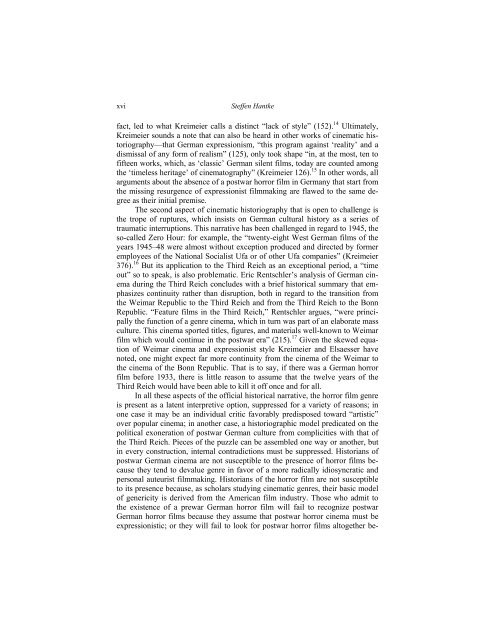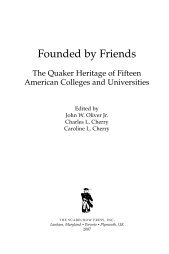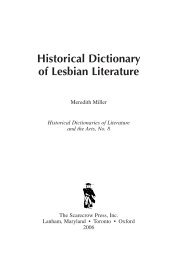Postwar German Cinema and the Horror Film - Scarecrow Press
Postwar German Cinema and the Horror Film - Scarecrow Press
Postwar German Cinema and the Horror Film - Scarecrow Press
Create successful ePaper yourself
Turn your PDF publications into a flip-book with our unique Google optimized e-Paper software.
xvi Steffen Hantke<br />
fact, led to what Kreimeier calls a distinct “lack of style” (152). 14 Ultimately,<br />
Kreimeier sounds a note that can also be heard in o<strong>the</strong>r works of cinematic historiography—that<br />
<strong>German</strong> expressionism, “this program against ‘reality’ <strong>and</strong> a<br />
dismissal of any form of realism” (125), only took shape “in, at <strong>the</strong> most, ten to<br />
fifteen works, which, as ‘classic’ <strong>German</strong> silent films, today are counted among<br />
<strong>the</strong> ‘timeless heritage’ of cinematography” (Kreimeier 126). 15 In o<strong>the</strong>r words, all<br />
arguments about <strong>the</strong> absence of a postwar horror film in <strong>German</strong>y that start from<br />
<strong>the</strong> missing resurgence of expressionist filmmaking are flawed to <strong>the</strong> same degree<br />
as <strong>the</strong>ir initial premise.<br />
The second aspect of cinematic historiography that is open to challenge is<br />
<strong>the</strong> trope of ruptures, which insists on <strong>German</strong> cultural history as a series of<br />
traumatic interruptions. This narrative has been challenged in regard to 1945, <strong>the</strong><br />
so-called Zero Hour: for example, <strong>the</strong> “twenty-eight West <strong>German</strong> films of <strong>the</strong><br />
years 1945–48 were almost without exception produced <strong>and</strong> directed by former<br />
employees of <strong>the</strong> National Socialist Ufa or of o<strong>the</strong>r Ufa companies” (Kreimeier<br />
376). 16 But its application to <strong>the</strong> Third Reich as an exceptional period, a “time<br />
out” so to speak, is also problematic. Eric Rentschler’s analysis of <strong>German</strong> cinema<br />
during <strong>the</strong> Third Reich concludes with a brief historical summary that emphasizes<br />
continuity ra<strong>the</strong>r than disruption, both in regard to <strong>the</strong> transition from<br />
<strong>the</strong> Weimar Republic to <strong>the</strong> Third Reich <strong>and</strong> from <strong>the</strong> Third Reich to <strong>the</strong> Bonn<br />
Republic. “Feature films in <strong>the</strong> Third Reich,” Rentschler argues, “were principally<br />
<strong>the</strong> function of a genre cinema, which in turn was part of an elaborate mass<br />
culture. This cinema sported titles, figures, <strong>and</strong> materials well-known to Weimar<br />
film which would continue in <strong>the</strong> postwar era” (215). 17 Given <strong>the</strong> skewed equation<br />
of Weimar cinema <strong>and</strong> expressionist style Kreimeier <strong>and</strong> Elsaesser have<br />
noted, one might expect far more continuity from <strong>the</strong> cinema of <strong>the</strong> Weimar to<br />
<strong>the</strong> cinema of <strong>the</strong> Bonn Republic. That is to say, if <strong>the</strong>re was a <strong>German</strong> horror<br />
film before 1933, <strong>the</strong>re is little reason to assume that <strong>the</strong> twelve years of <strong>the</strong><br />
Third Reich would have been able to kill it off once <strong>and</strong> for all.<br />
In all <strong>the</strong>se aspects of <strong>the</strong> official historical narrative, <strong>the</strong> horror film genre<br />
is present as a latent interpretive option, suppressed for a variety of reasons; in<br />
one case it may be an individual critic favorably predisposed toward “artistic”<br />
over popular cinema; in ano<strong>the</strong>r case, a historiographic model predicated on <strong>the</strong><br />
political exoneration of postwar <strong>German</strong> culture from complicities with that of<br />
<strong>the</strong> Third Reich. Pieces of <strong>the</strong> puzzle can be assembled one way or ano<strong>the</strong>r, but<br />
in every construction, internal contradictions must be suppressed. Historians of<br />
postwar <strong>German</strong> cinema are not susceptible to <strong>the</strong> presence of horror films because<br />
<strong>the</strong>y tend to devalue genre in favor of a more radically idiosyncratic <strong>and</strong><br />
personal auteurist filmmaking. Historians of <strong>the</strong> horror film are not susceptible<br />
to its presence because, as scholars studying cinematic genres, <strong>the</strong>ir basic model<br />
of genericity is derived from <strong>the</strong> American film industry. Those who admit to<br />
<strong>the</strong> existence of a prewar <strong>German</strong> horror film will fail to recognize postwar<br />
<strong>German</strong> horror films because <strong>the</strong>y assume that postwar horror cinema must be<br />
expressionistic; or <strong>the</strong>y will fail to look for postwar horror films altoge<strong>the</strong>r be-
















